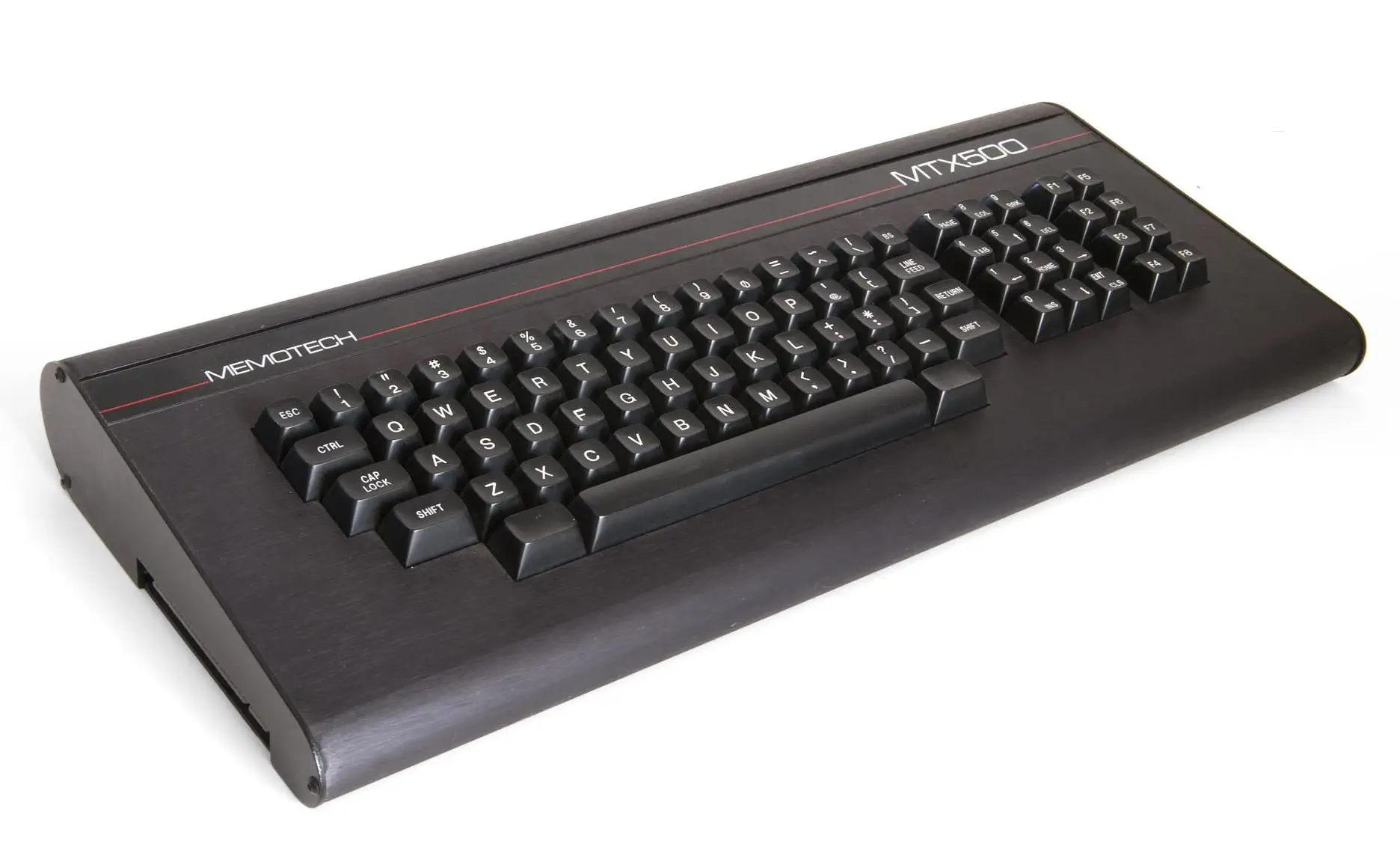Memotech MTX-500
The Memotech MTX-500 was released in 1983. It had 32KByte of RAM and a Zilog Z80A CPU. It also used a TMS9918 or TMS9928 Video Display Processor, which has the VDP of choice for the MSX-1 range of computers.
The Memotech MTX computer line
The Memotech MTX computers came in an all aluminium case with a full sized keyboard and full-stroke keys. Built in was a BASIC interpereter with rudimentary windowing and LOGO command support. The system had cartridge support and could be expanded by an FDX system, which added 5.25" Floppy disk drives, Winchester hard disks using the CP/M 2.2 OS. The FDX expansion was very expensive.
In 1984 Memotech was working on a project to deliver the MTX-512 combined with the FDX and an I/O control system developed by Norbit Elektronikk Norge, to 64000 schools across the Soviet Union. At the time the Soviet Union was prohibited to buy IBM Personal Computers from the US, but CP/M computers were not part of the embargo.
Memotech made a substantial investment in order to prepare the deal for the Soviets. A special red case was designed and manufactured in The Netherlands, BASIC, character encoding, manuals, and keyboard all had to be adapted to the Russian language and character set. As a result Memotech required the USSR cash payments prior to the delivery of the computers. The Soviets decided against this, and bought MSX computers from Yamaha and Daewoo instead. The deal fell through for Memotech and the company went bankrupt
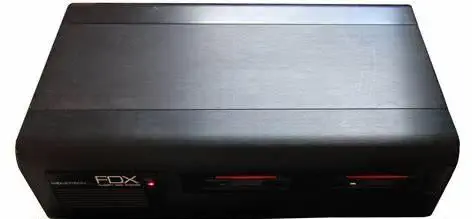
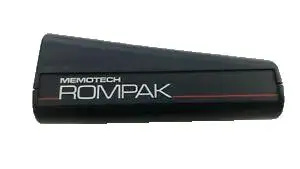
Zilog Z80 CPU Family
The Z80 quickly became popular in the personal computer market, with many early personal computers, such as the TRS-80 and Sinclair ZX80, using the Z80 as their central processing unit (CPU). It was also widely used in home computers, such as the MSX range, SORD, and the Amstrad CPC, as well as in many arcade games. Additionally, it was also used in other applications such as industrial control systems, and embedded systems. The Z80 was widely used until the mid-1980s, when it was gradually replaced by newer microprocessors such as the Intel 80286 and the Motorola 68000.
The Z80 microprocessor was developed by Zilog, a company founded by Federico Faggin in 1974. The Z80 was released in July 1976, as a successor to the Intel 8080. It was designed to be fully compatible with the 8080, but also included new features such as an improved instruction set, more powerful interrupts, and a more sophisticated memory management system.
The Z80 quickly became popular in the personal computer market, with many early personal computers, such as the TRS-80 and Sinclair ZX80, using the Z80 as their central processing unit (CPU). It was also widely used in home computers, such as the MSX range, SORD, and the Amstrad CPC, as well as in many arcade games. Additionally, it was also used in other applications such as industrial control systems, and embedded systems. The Z80 was widely used until the mid-1980s, when it was gradually replaced by newer microprocessors such as the Intel 80286 and the Motorola 68000. The design was licensed to Synertek and Mostek as well as the European SGS.
The Z80s instruction set is binary compatible with the Intel 8080, so that 8080 code such as the CP/M Operating System and Intel's PL/M compiler for the 8080 can run unmodified on the Z80. The Z80 had many enhancements over the 8080 such as 16-bit data movement instructions, block copy and block I/O instructions, single bit addressing of all registers, IX/IY offset registers, better interrupt system and a complete duplicate register file for context switching during an interrupt.
Source: WikiPedia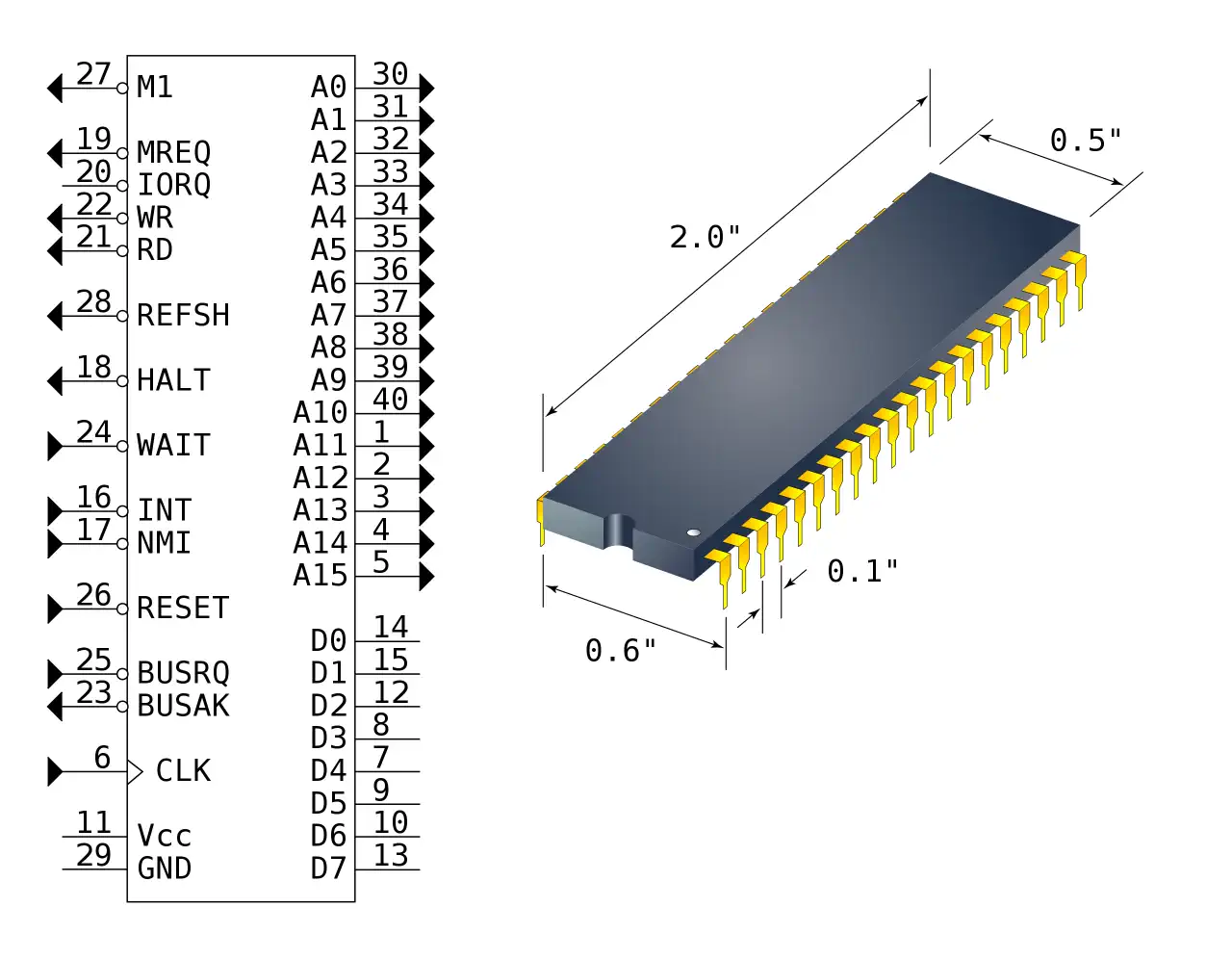
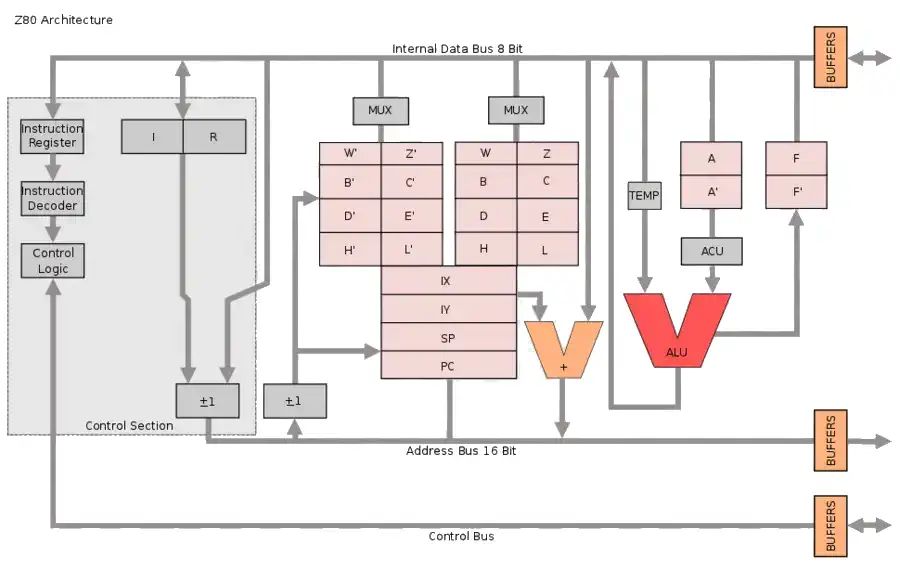
TMS9918 Series Video Display Processor (99n8, 99n9, 91n8, 91n9)
The TMS9918 is a series of video display controllers (VDC) manufactured in 1979 by Texas Instruments, also refered to as 'Video Display Processor' (VDP). The TMS9918 and its variants were used in the ColecoVision, CreatiVision, Memotech MTX, MSX, NABU Personal Computer, SG-1000/SC-3000, Spectravideo SV-318, Spectravideo SV-328, Sord M5, Tatung Einstein, Texas Instruments TI-99/4, Casio PV-2000, Coleco Adam, Hanimex Pencil II, and Tomy Tutor.
Key Features:
- 256x192 pattern based color pixels per screen
- 16 different colors
- 8-bit memory mapped CPU interface
- No need for DMA, CPU can access VRAM
- 32 single color Sprites per screen (4 per scanline)
Variants:
- TMS9918A - 60Hz output, NTSC video
- TMS9928A - 60Hz output, YPbPr video
- TMS9929A - 50Hz output, YPbPr video
- TMS9118 - Different RAM than TMS9918A, otherwise identical
- TMS9128 - Different RAM than TMS9928A, otherwise identical
- TMS9129 - Different RAM than TMS9929A, otherwise identical
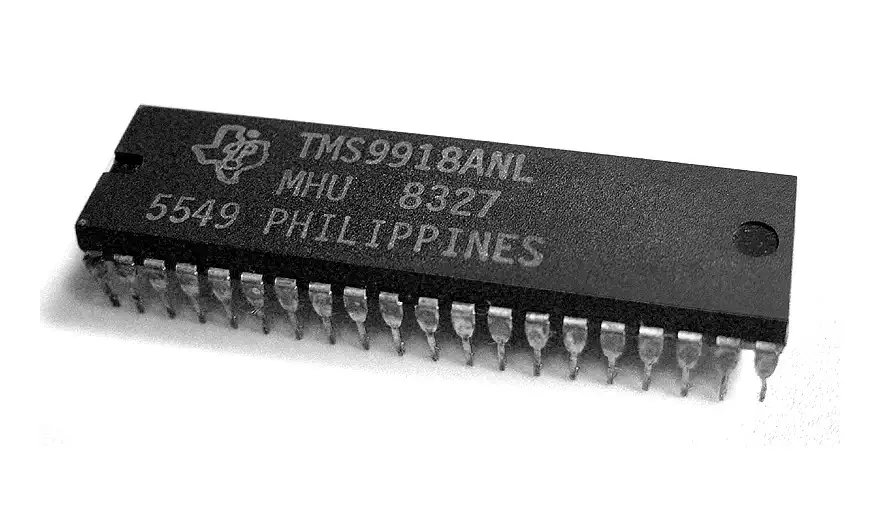
Texas Instruments SN76489 Sound Generator
THe SN76489 Digital Complex Sound Generator (DCSG) is a TTL compatible programmable sound generator chip created by Texas Instruments. It main application was the generation of music and sound effects in home computers, arcade machines and home game consoles. Functionally the chip was similar to the General Instrument AY-3-8910.
SOund Capabilities:
- 3 Square Wave tone generators, 16 volume levels
- 1 White Noise Generator (white and periodic noice, 3 frequencies, 16 volumes)
The SN76489 Was originally designed to be used in the TI-99/4 computer, where it was first called the TMS9919 and later SN94624, and had a 500 kHz max clock input rate. Later, when it was sold outside of TI, it was renamed the SN76489, and a divide-by-8 was added to its clock input, increasing the max clock input rate to 4 MHz, to facilitate sharing a crystal for both NTSC colorburst and clocking the sound chip. A version of the chip without the divide-by-8 input was also sold outside of TI as the SN76494, which has a 500 kHz max clock input rate.
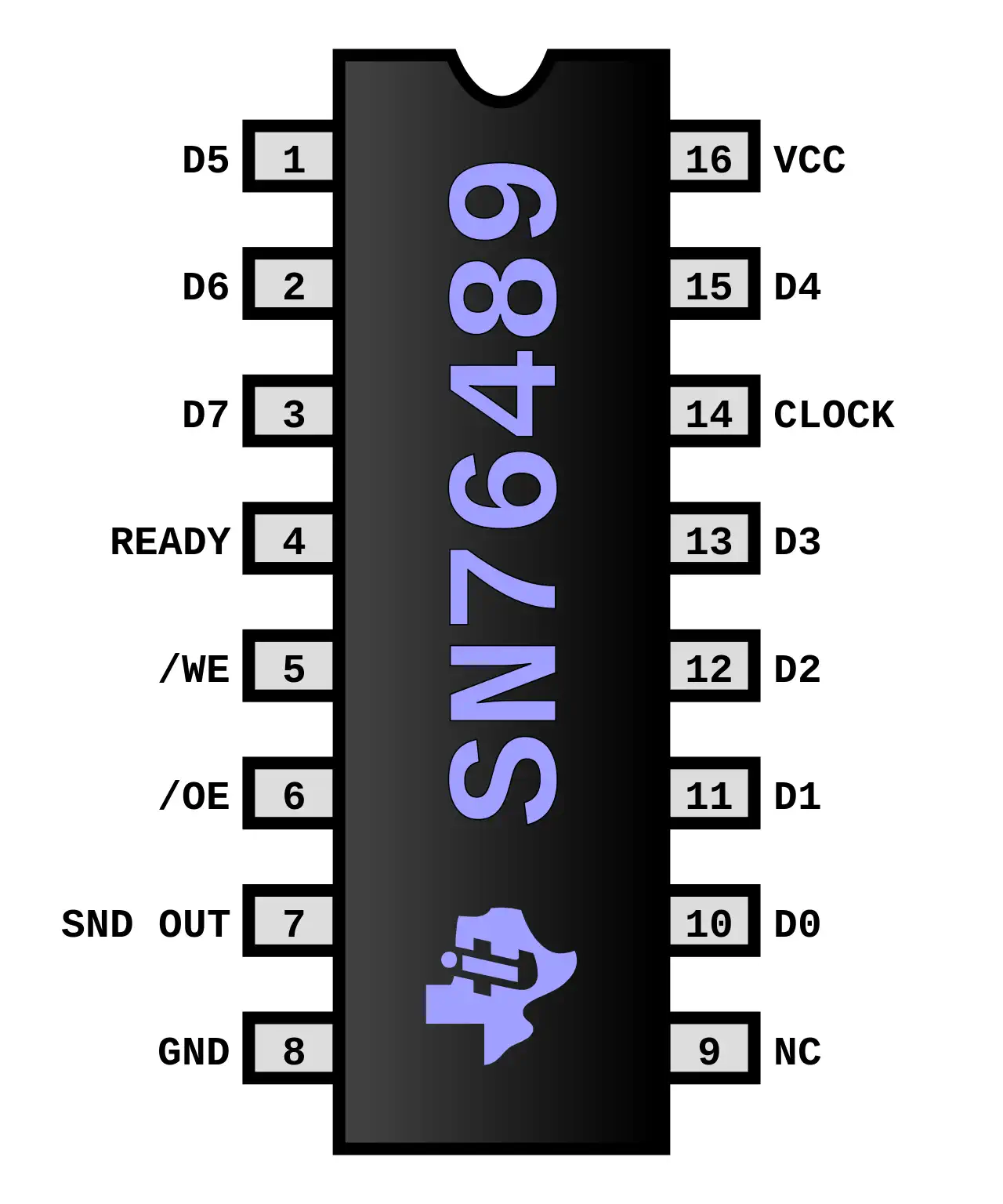
1 noise generator
16 volume levels. Display Chip TM9919 or 9928 Display 80x24 text
40x24 text
256x192 pattern based graphics, 16 color. Best Text 80x24 Best Color 16 colors (2 per 8 pixels) Best Graphics 256x192 in 16 colors Sprites 16 color, 16x16, 8/scanline, 64 total System OS CP/M, Basic

